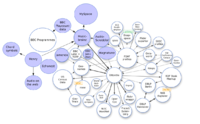
Photo from wikipedia
In this paper, we present the Pipeline for Observational Data Processing, Analysis, and Collaboration (PODPAC) software. PODPAC is an open-source Python library designed to enable widespread exploitation of NASA earth… Click to show full abstract
In this paper, we present the Pipeline for Observational Data Processing, Analysis, and Collaboration (PODPAC) software. PODPAC is an open-source Python library designed to enable widespread exploitation of NASA earth science data by enabling multi-scale and multi-windowed access, exploration, and integration of available earth science datasets to support analysis and analytics; automatic accounting for geospatial data formats, projections, and resolutions; simplified implementation and parallelization of geospatial data processing routines; standardized sharing of data and algorithms; and seamless transition of algorithms and data products from local development to distributed, serverless processing on commercial cloud computing environments. We describe the key elements of PODPAC’s architecture, including Nodes for unified encapsulation of disparate scientific data sources; Algorithms for plug-and-play processing and harmonization of multiple data source Nodes; and Lambda functions for serverless execution and sharing of new data products via the cloud. We provide an overview of our open-source code implementation and testing process for development and deployment of PODPAC. We describe our interactive, JupyterLab-based end-user documentation including quick-start examples and detailed use case studies. We conclude with examples of PODPAC’s application to: encapsulate data sources available on Amazon Web Services (AWS) Open Data repository; harmonize processing of multiple earth science data sets for downscaling of NASA Soil Moisture Active Passive (SMAP) soil moisture data; and deploy a serverless SMAP-based drought monitoring application for use access from mobile devices. We postulate that PODPAC will also be an effective tool for wrangling and standardizing massive earth science data sets for use in model training for machine learning applications.
Journal Title: Earth Science Informatics
Year Published: 2020
Link to full text (if available)
Share on Social Media: Sign Up to like & get
recommendations!